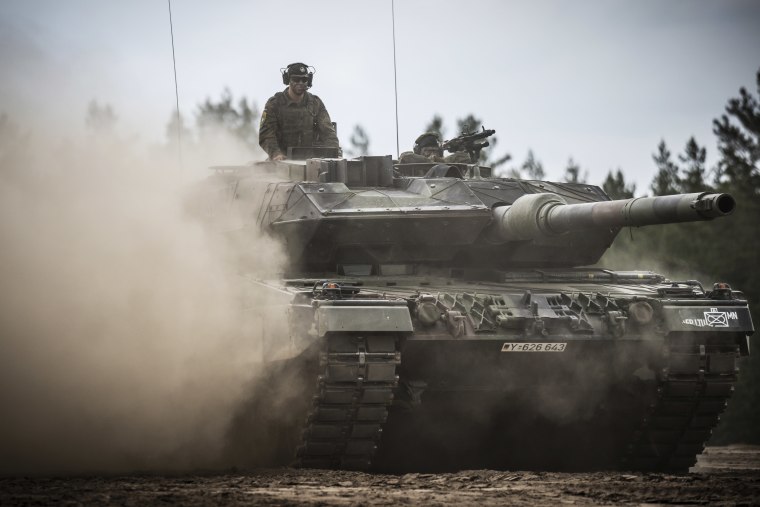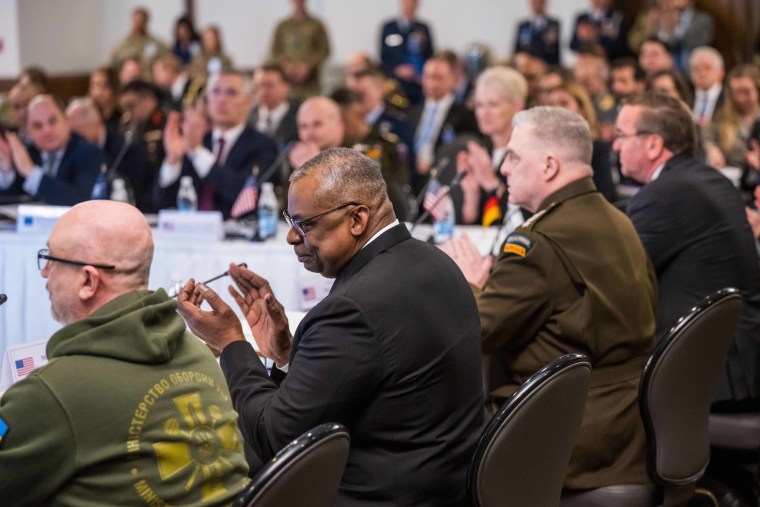Ukraine is set to receive battle tanks from Germany and other Western countries after a fierce debate that exposed fissures among its allies ahead of an expected Russian spring offensive.
The German government said Wednesday it would quickly provide 14 Leopard 2 tanks as a "first step" and would allow other European countries to send their own Leopard tanks soon. The training of Ukrainian soldiers in using them will begin quickly, Germany said, alongside the provision of maintenance and ammunition.
“This decision follows our well-known line of supporting Ukraine to the best of our ability. We are acting in a closely coordinated manner internationally,” Chancellor Olaf Scholz said in a statement.
President Joe Biden announced Wednesday that the U.S. is sending 31 Abrams tanks to Ukraine in a reversal.

Biden said sending the tanks will “enhance Ukraine’s capacity to defend its territory and achieve its strategic objectives,” because they are “the most capable tanks in the world.” The U.S. will also provide the training and supplies needed to operate and run the tanks, he added.
The Polish government officially asked Germany on Tuesday to sign off on plans to send Leopard 2 tanks to the battlefield — the culmination of a weekslong pressure campaign on Europe's leading power to do more to back Ukraine's cause at a key moment in the 11-month war.
Germany, which makes the heavy tanks, needs to grant permission for the arms to be sent to a non-NATO country. Ukrainian military leaders have said they need hundreds of the tanks to break through Russian defenses. There are an estimated 2,000 Leopard 2 tanks in Europe, including several hundred in Germany alone, according to the International Institute of Strategic Studies, a think tank.
President Volodymyr Zelenskyy led Ukrainian officials in celebrating the announcement and thanking Scholz for what he called an "important & timely" move.
'Free the leopards'
Germany has provided billions in humanitarian and military aid since the start of the war, but Scholz has broadly held to a cautious approach rooted in his country's weighty history and political culture. Many Germans remain anxious about the image of their tanks' once again rolling toward the Russian border and wary of being seen as responsible for escalation on European soil.
The reluctance sparked criticism from Ukraine, Poland and the Baltic countries, which have long urged a more robust response to combat Russia’s expansionist goals.
Thousands of protesters have gathered outside Parliament in Berlin, while Ukraine's government has promoted a social media campaign calling on Germany to “free the leopards.”
After Wednesday's announcement, Ukrainian Defense Minister Oleksii Reznikov said on Twitter there was “more to come!”
Zelenskyy has been asking for increased firepower since before Russia invaded last February.
He and his advisers have made it clear that the hardware previously offered by the country's allies would not be enough for Ukraine to recapture its territory, especially as both sides gear up for what many expect to be an intense period of crucial fighting once the winter is over.
“In order for us to defeat the Russian Federation, we absolutely need tanks,” Oleksiy Danilov, the secretary of the National Security and Defense Council of Ukraine, said in an interview last week.
Germany has more than 300 active Leopard tanks and more in storage. Poland has pledged to send a company of the tanks, typically 14, but it has said the deployment would make more sense as part of an international brigade. Several countries use Leopard tanks, including Canada, the Netherlands and Sweden.
The United Kingdom has already pledged to send 14 Challenger 2 tanks to the Ukrainian front line.
The U.S. had been frustrated with Germany’s efforts to pressure Washington on the subject, three U.S. officials said last week, after Berlin signaled it would be more willing to provide tanks if Washington sent its own M1 Abrams tanks to Ukraine.
Deploying the tanks will be a gradual process.
Ukrainian troops need to be properly trained, while the tanks require parts for maintenance and are normally deployed alongside infantry units with their own procurement and training needs.
Ukraine believes the tanks could help it not just defend its territory but also win back land occupied by Russia since the start of this war.
But despite the significance of Germany's announcement, the effect on the direction of the war may be not just delayed but also limited, an analyst said.
“The question is whether 100 tanks of different varieties will be enough to eject Russian forces from Ukraine. My bet is that it won’t," said Matthew Ford, an associate professor at the Swedish Defense University in Stockholm.
"With 300, there might be more chance of doing it, but you have to remember that Russia is doing the same thing," he said, referring to rearming and redeploying.
Ford added that it was far from certain that any foreign tanks would be ready for combat ahead of an anticipated Russian spring offensive. The deployment of Leopard tanks was the most significant, he said, because of their conventional diesel-powered engines, as opposed to Abrams tanks, which are powered by jet fuel.
“I still don’t think this war is over this year, and it does not matter that tanks are being provided. It looks to me that the Russians are busily creating their own combat power, so we have another race of who can build up arms the quickest," he said.
Russia has consistently warned that ever-increasing Western military supplies could cause a dangerous escalation between nuclear-armed powers.
Kremlin spokesman Dmitry Peskov described German and U.S. plans for the tanks as “a rather disastrous plan.”
“The main thing is this is a completely obvious overestimation of the potential would add to the armed forces of Ukraine. It is yet another fallacy, a rather profound one,” he told reporters Wednesday.

Peskov predicted that “these tanks will burn down just like all the other ones.”
“Except they cost a lot, and this will fall on the shoulders of European taxpayers,” he added.
Russian President Vladimir Putin this month replaced the commander leading his forces in Ukraine after months of battlefield setbacks and domestic criticism.
But Russia did claim its first victory in months on the eastern front lines of the war by taking the mining town of Soledar as part of its bloody campaign to seize the nearby city of Bakhmut — although it was unclear how much of the operation was carried out by the Russian military or mercenaries from the Wagner Group.
Ukraine finally confirmed Wednesday that its forces had withdrawn from Soledar, nearly two weeks after Moscow claimed victory there.
